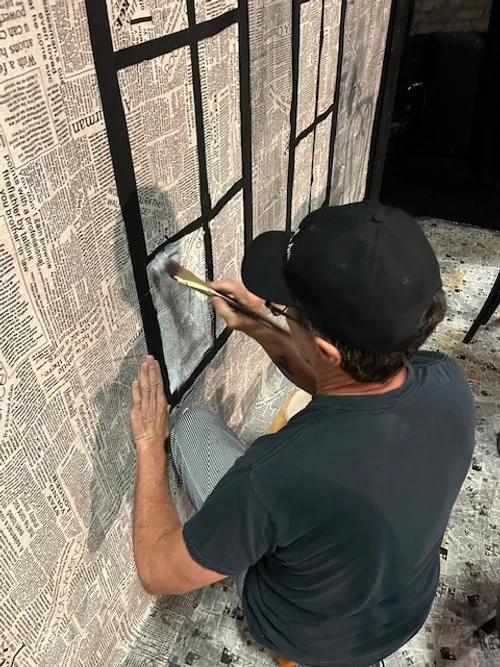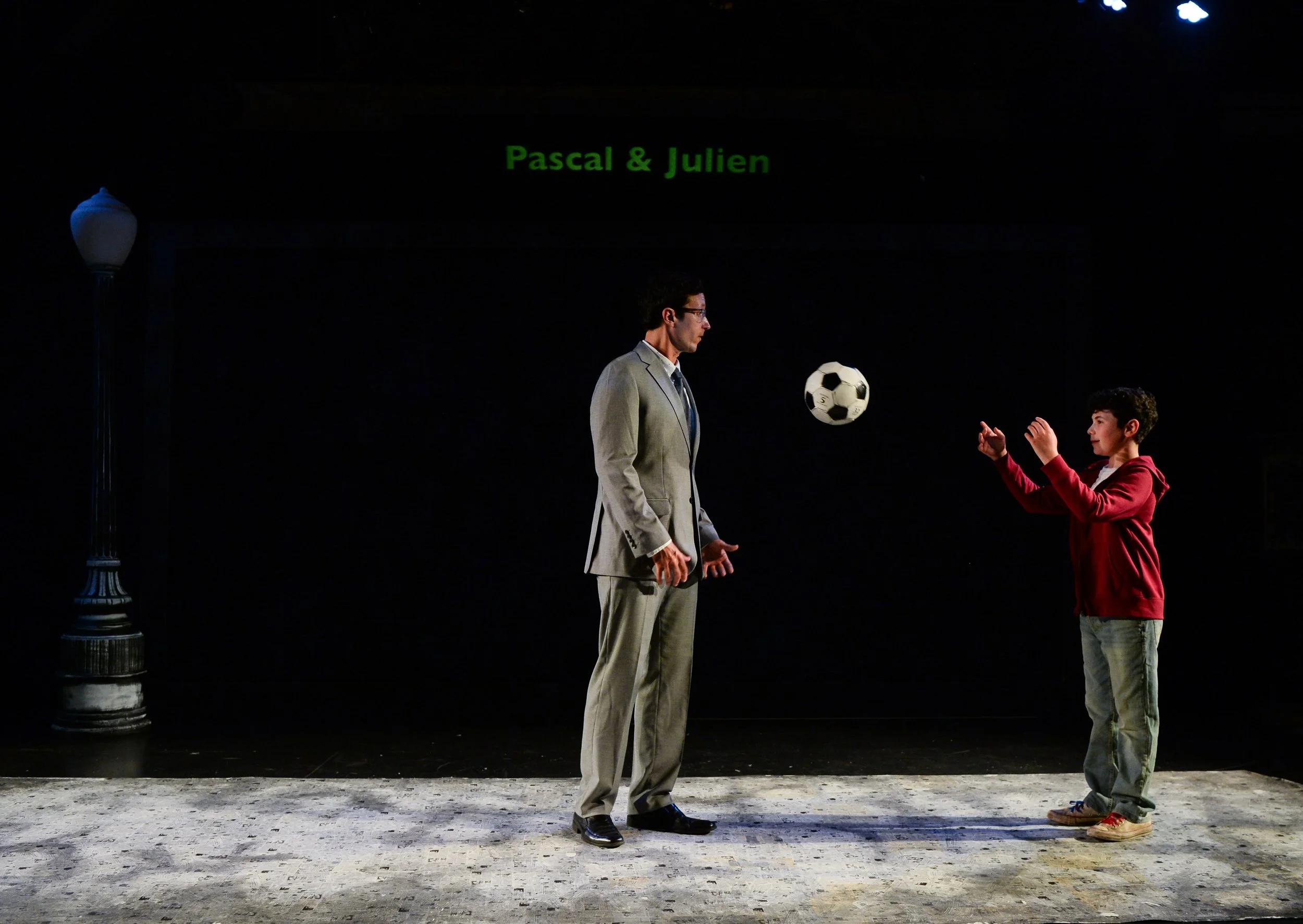Magic / Magia
Our Artistic Director, Debbie Devine, likes to brag that “We’ve never done a show with a couch as part of the set.”
That’s because even when we do absolute realism, we still like to add an element of magic. So a living room, or psychiatrist’s office, or even a furniture store, anywhere you’d find a couch in real life, would not be realistically represented in our scenic design, even with a scene done without any stylization in the acting.
One reason is our set designer, Keith Mitchell. We’ve been working with Keith for over 20 years and have loved every piece he’s built for us. Everything he builds is somewhat stylized. In our play Pascal & Julien, by Daniel Keene, Keith used the concept of Pascal’s hobby, crossword puzzles, and his occupation as a writer/journalist as key elements of the set design. Keith created the patio of a French café with newsprint-covered fabric. Then he built an awning out of cardboard that he covered with newsprint tissue, and gave it a red wash to make it pop on the black and white newsprint fabric wall. He taped out French windows, then painted over the fabric to accent windows. The floor of the café is also covered with newsprint tissue on linoleum. From afar it looks like a pretty realistic café façade. Up close, you can tell how stylized it all actually is.
The other reason you’ve never seen a realistic living room on our stage is our Artistic Director. Deb thinks theatre should be minimal, with the story and the actors carrying it. She uses pantomime and tableaux, which throws many adult actors. She believes what makes theatre special is that the audience in live theatre can fill in the blanks. An actor in the legitimate theatre can pantomime a prop and the audiences will recognize it and factor it into the production. A film actor can rarely do that.
“Why would we put on our stage anything that can be done on TV?” Deb says. “100% Realism is for movies. The only thing that should be 100% realistic on stage are the actors.”
Part of the deal with live theatre audience is that they know that theatre isn’t 100% realistic about everything. How many different ways have you seen stage actors represent driving in a car? You’ve seen everything from an actor sitting on a rehearsal cube and miming the steering wheel, to a real car driving onto the stage. It could be just an actor standing and holding a steering wheel. Or an actor sitting on a tricycle being pushed around the stage. However abstractly driving is depicted, a live theatre audience will go along with it.
We have much video magic in Pascal & Julien thanks to video genius Matt Hill. Matt makes more than 1700 roto-scoped images flow like water to wash us from scene to scene. Deb also uses Brad Brough’s original score to bring the feeling of magic to many moments of the piece and Dan Weingarten’s lighting adds poignancy and starkness to many scenes. Shannon Kennedy’s costumes look realistic, but there are no costume changes for the year of seasons we go through. Just scarves added for winter, a sports coat used as a heavier coat. Chima rigged a soccer ball to drop from the ceiling in one scene, just to add some magic. When the ball drops, people gasp, but then the scene goes on and nobody questions it. Because we’re in the live theatre. One of the few places where magic still exists.
GET TIX Pascal & Julien
https://www.eventbrite.com/e/pascal-julien-tickets-972530363497?aff=oddtdtcreator
Scenic Designer Keith Mitchell creates French windows
A nuestra directora artística, Debbie Devine, le gusta alardear de que "nunca hemos hecho un espectáculo con un sofá como parte de la escenografía".
Esto se debe a que incluso cuando hacemos un realismo absoluto, todavía nos gusta agregar un elemento de magia. Por lo tanto, una sala de estar, un consultorio de psiquiatra o incluso una tienda de muebles, cualquier lugar donde encontrarías un sofá en la vida real, no estaría representado de manera realista en nuestro diseño escénico, incluso con una escena sin ninguna estilización al representarla.
Una de las razones es nuestro escenógrafo, Keith Mitchell. Llevamos más de 20 años trabajando con Keith y nos encanta cada pieza que ha construido para nosotros. Todo lo que construye es algo estilizado. En nuestra obra Pascal & Julien, de Daniel Keene, Keith utilizó el concepto del pasatiempo de Pascal, los crucigramas y su ocupación de escritor/periodista como elementos clave del diseño del escenario. Keith creó el patio de un café francés con tela cubierta de papel de periódico. Luego construyó un toldo con cartón que cubrió con papel de periódico y le dio un lavado rojo para que resaltara en la pared de tela de papel de periódico en blanco y negro. Puso cinta adhesiva en las ventanas francesas y luego pintó sobre la tela para acentuar las ventanas. El suelo de la cafetería también está cubierto con papel de periódico sobre linóleo. Desde lejos parece la fachada de un café bastante realista. De cerca se puede ver lo estilizado que está todo.
La otra razón por la que nunca has visto una sala de estar realista en nuestro escenario es nuestro Director Artístico. Deb cree que el teatro debería ser mínimo, con la historia y los actores transmitiéndola. Utiliza pantomima y cuadros plásticos, lo que desconcierta a muchos actores adultos. Ella cree que lo que hace que el teatro sea especial es que el público de teatro puede llenar los espacios en blanco. Un actor en el teatro puede hacer pantomima sobre un accesorio y el público lo reconocerá y lo tendrá en cuenta en la producción. Un actor de cine rara vez puede hacer eso.
“¿Por qué pondríamos en nuestro escenario algo que se puede hacer en televisión?” dice Deb. “El realismo al 100% es para películas. Lo único que debería ser 100% realista en el escenario son los actores”.
Parte del trato con el público del teatro es que saben de antemano que el teatro no es 100% realista. ¿De cuántas maneras diferentes has visto a los actores de teatro representar la conducción de un coche? Has visto de todo, desde un actor sentado en un cubo de ensayo e imitando el volante, hasta un automóvil real subiendo al escenario. Podría ser simplemente un actor de pie y sosteniendo un volante. O un actor sentado en un triciclo siendo empujado por el escenario. Por muy abstracta que sea la representación en la conducción del automóvil, el público del teatro lo entenderá.
Tenemos mucha magia de video en Pascal & Julien gracias al genio del video, Matt Hill. Matt hace que más de 1700 imágenes rotoscópicas fluyan como agua para lavarnos de una escena a otra. Deb también utiliza la partitura original de Brad Brough para aportar una sensación de magia a muchos momentos de la pieza y la iluminación de Dan Weingarten añade intensidad y crudeza a muchas escenas. Los vestuarios de Shannon Kennedy parecen realistas, pero no hay cambios de vestuario para las diferentes estaciones que atravesamos durante un año. Solo se agregaron bufandas para el invierno, un abrigo deportivo usado como un abrigo más grueso. Chima, incluso, se las ingenió para que un balón de fútbol cayera del techo en una escena, solo para agregar algo más de magia. Cuando cae la pelota, la gente se sorprende, pero luego la escena continúa y nadie lo cuestiona. Porque estamos en el teatro. Uno de los pocos lugares donde todavía existe la magia.
OBTENGA sus boletos Pascal y Julien
https://www.eventbrite.com/e/pascal-julien-tickets-972530363497?aff=oddtdtcreator
Paul Turbiak (L) and Jude Schwartz in Daniel Keene's play Pascal & Julien now playing at 24th Street Theatre.


